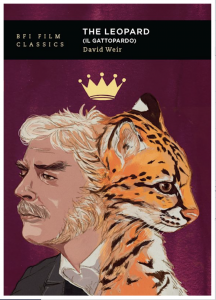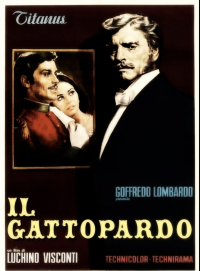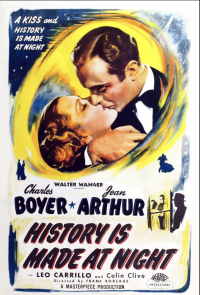



Jeff Godsil discusses the romance from History is Made at Night.
Then W. C. Fields in It's a Gift.
We look at the latest BFI Screen Classics book on Visconti's The Leopard.
__________________________________________________________
Back in the 1920s, the Lord of Magnificence and Expenditure was Eric Von Stroheim. In a series of epical films set within European aristocracy such as Blind Tusbands, The Wedding Party and Foolish Wives he explored the mores of the sort of people that one would think his “Von”indicated were his milieu. His extravagance included having various characters wear exquisite underwear, despite the fact that the audience would not see it. Sadly, this extravagance, inevitably, led to a clash with his studio, MGM, and his career was slowly dismantled, not unlike that of Orson Wells in the ’40s.
And yet 60 years later in Italy, Luchino Visconti evinced much the same extravagance. There is an anecdote in which Burt Lancaster, the lead player in The Leopard from 1963, walked over to a clothes bureau, open the top drawer, and found an array of, expensive handkerchiefs, towelettes, and other sundries on display, that may or may not have been used in any scenes. Visconti was never "punished" for this excess, and instead enjoy a fruitful career, not just in cinema, but with over 60 plays in the theater and almost 20 opera productions.
The evidence suggests that Visconti simply did it correctly. After all, in the ‘60s, numerous studios such as Warner Bros., MGM, and Fox, were in freefall, mostly due to continuing to offer viewers movies as if the time were still 1952. And the slaughter continued. Michael Cimino is blamed for the total destruction of United Artists, to riot and understatement, thanks to his film Heaven's Gate. Indeed, the company that released The Leopard in Italy, Titanus, itself collapsed shortly afterwards, though due to a film released the previous year.
Lancaster’s anecdote is referenced in the new British Film Institute’s Film Classics monograph on Visconti's The Leopard, which proves to be one of the best books in the series, not simply for the simplicity of its organization, but for the wealth of detail found in the chapters. Author David Weir is Associate Professor on the Faculty of Humanities and Social Sciences at The Cooper Union for the Advancement of Science and Art, and is a specialist on James Joyce, decadence and aesthetics, and European cinema, among other topics.
Visconti was the scion of an aristocratic family, indeed he was a count, but at the same time he was a dedicated communist. That he could believe one thing and make a different kind of movie is explained by a writer, the author, quotes:
The book is divided into a handful of chapters.
The first gives a summary of the source novel, its reception, and Italian history in the years around 1860 which are pertinent to key narrative transitions. The next chapter charts Viscontis’s increasingly period-set and operatic-style dramas after his earlier neorealist phase.
The next chapter concentrates on the production of The Leopard, which is where we find the Burt Lancaster anecdote, and the following chapter digs into the meat of the film, a scene-by-scene, sometimes shot-by-shot consideration of what the film’s unconventional plot and narrative are getting up to. If you want to know why Tancredi first appears reflected the Prince’s hand mirror, here is the answer; if you are curious about the reaction of Claudia Cardinale's laugh after Tancredi tells her a "blue" story at a mammoth dinner party, the moment is anatomized; if you didn't notice something significant about the last few seconds of the film’s final shot, here is the reminder.
Finally, the book covers the film’s legacy, its immediate impact, its influence, and the various international directors who found inspiration in the film, such as Martin Scorsese while he was making The Age of Innocence, and Coppola while shooting the opening wedding reception in The Godfather.
Importantly, Professor Weir notes that busy, antic, contemporaneous films such as Fellini’s 8 1/2 seemed to reflect the vitality of counter-Hollywood cinema of the time, but The Leopard over the next decade became the true model, with its stately pace, its structure as a series of operatic sequences without the interstitial linking that the traditional screenplay insists upon for clarity. He explains thus:
To a non-Italian, indeed the non-European audience, the film will probably seem baffling, slow paced, and irrelevant. For one thing, one has to know a great deal about the Italian unification movement of the mid 1800s, as the film is set within these events, but does not explain them contextually as would a normal Hollywood screenplay. In addition, the film is a series of sequences, somewhere between 15 and 20 of them, with a few flashbacks inserted, that simply charts the seemingly innocuous doings of the Prince’s family in that context.
For added heft, the film concludes with a 48-minute sequence set in an annual fete in which the Prince wanders from room to room, gauging the decline of his aristocratic society into mere greed, self-promotion, and political manipulation The lowest point occurs when he pauses in a room joined to a small vestibule stacked with bed pans or bed pots, haphazardly stacked, each filled to the brim with urine.
Here is how Professor Weir concludes his book, finally returning to the key concept of decadence, which he introduced in the first chapter:
The Leopard (Il Gattopardo) is published 4 April, 2024 by Bloomsbury on behalf of the BFI, 120 pages, ISBN 9781839026157, with 60 color illustrations.
- KBOO


